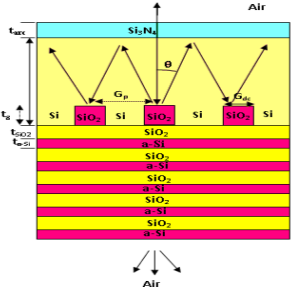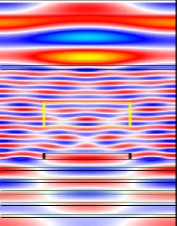Light Trapping Properties of Solar Cells
| ✅ Paper Type: Free Essay | ✅ Subject: Physics |
| ✅ Wordcount: 1538 words | ✅ Published: 09 Mar 2018 |
Abstract
In this paper, we have investigated the light trapping properties of solar cells based on one-dimensional photonic crystal (1DPC) by using finite difference time domain (FDTD) method. Light trapping is essential for thin film solar cells due to the limited absorption in long wavelength range. Here, we used different types of solar cell structures and to explore their photonic ray theories (electric field propagation) and numerical simulations. The one-dimensional thin film solar cell consists of distributed Bragg’s reflector (DBR), Metal back reflector, grating and anti-reflection coating (ARC). The influence of the grating period and depth, the optimal path length has to be increased. These numerical simulations indicate that this combined photonic structure is capable of improving the external quantum efficiency and their absorption. As well as the relative enhancement increased up-to 60% for thin film silicon solar cells. We further to investigate high efficiency of thin film solar cell using different structure.
Index terms: Finite difference time domain (FDTD), distributed Bragg’s reflector (DBR), the grating, metal reflector, anti-reflection coating (ARC) and relative enhancement factor.
Introduction
The scientific community is intensively working to achieve high efficiency thin film solar cells based on silicon. Among the various energy sources, solar energy is well considered to be very promising and achieved wide applications for space and global power generation. The silicon based thin films are cheaper and easy fabrication due to well developed silicon technology. The Silicon based thin films have been the choice as active materials for solar cells, such as crystalline silicon (c-Si), amorphous silicon (a-Si), micro crystalline silicon (μc-Si) and so on [1]. The efficiency of silicon thin film solar cell (TFSC) is low due to their weak absorption in longer wavelength range. Thus the light trapping mechanism for thin film silicon solar cell becomes a vital role to improve the conversion efficiency. The crystalline silicon solar cells integrated with the DBR, metal reflector, ARC and grating. Therefore, the incident light is expected to be partially absorbed in the active layer of crystalline silicon (c-Si), after the support through the front anti-reflection coating layer (Si3N4) and the back reflector of aluminum (Al) or dielectric (DBR) layers.
We are realized that incident light is scattered into the DBR due to the periodic grating and reflected back at the bottom interface. Therefore the way of light trapping in this design is different from usual reflectors based on metals or photonic crystals [2, 3]. In this paper, we will focus on strongly corrugated photonic crystal absorbers made up of a-Si and SiO2 layers are periodically patterned. Finally, the optical presentation of the structure will be indicated by their integrated absorption, the absorbed spectral range between 300-1200nm. This paper deals with the modeling and designing of solar cells using FDTD method.
 Figure 1 The schematic diagram of the solar cell structure
Figure 1 The schematic diagram of the solar cell structure
Designing Approach
Finite difference time domain (FDTD) method as a sophisticated computational method used to model advanced devices. Figure 1 shows a schematic diagram of solar cell composed of anti-reflection coating (ARC), diffraction grating and photonic crystals also known as distributed Bragg’s reflector. The distributed Bragg’s reflector (DBR) consists of alternate layers of amorphous Si (a-Si) and silicon-di-oxide (SiO2) with their refractive index 3.6 and 1.45 and thickness 56nm, 138nm respectively. The thickness of the each layer is determined by the quarter wave principle (t = λC /4n), where, n-is the refractive index and λC is the center wavelength of photonic band gap. On top of the DBR, diffraction grating is embedded which is made of a-Si and SiO2, with duty cycle (Gdc=0.5μm), period (Gp=0.6μm) and thickness (Tg=0.1μm).The anti-reflection coating (ARC) layer is made of silicon nitrate (Si3N4) and their thickness 0.07μm.
Result and Discussion
The wave propagation designed solar cell is shown in figure 2. We have used commercial available Full WAVE tool supplied by RSoft. We can see light interaction into the device, when one light is made incident on the solar cell. The shorter wavelength is absorbed by the active region while longer wavelength moves toward bottom layer. The grating interaction gives scattering and diffraction of light where as DBR reflects remaining light. This mechanism finally force the light waves into active region. We have designed and analyzed four different structures of solar cells to understand the light trapping mechanism.
 Figure 2 Schematic diagrams of solar cell structure and their electric field distribution
Figure 2 Schematic diagrams of solar cell structure and their electric field distribution
Figure 3 (a) show absorption of solar cells in accordance to wavelength from 300 to 1200nm. To compare the performance of designed devices we have designed a planer solar cell which mainly consists of anti-reflection coating of silicon nitride. The solar cell absorption of DBR and ARC based solar cell is found to be improved than reference solar cell. However, DBR, ARC and GRA based solar cells show distinct absorption as comparisons to cell C1 and C3. We can see added absorption peak in the red and infrared part of solar spectrum for the case of cell 2.



Figure 3 Absorption (a) and Quantum efficiency (b) of designed four solar cells
Figure 3b shows Quantum efficiency of different types of thin film Silicon solar cells. The solar cell (C2) composed of DBR, ARC and GR Solar cell C2 shows enhanced quantum efficiency then solar cells C1 and C3. The solar cell C2 peaks between 600 and 1160nm range, which indicates the efficient trapping of light. However, reference cell has the less quantum efficiency show sharp as compare to cells C1 and C3. The overall quantum efficiency is found to be increased between the 700 to 1160nm wavelength range. The quantum efficiency clearly exposes the light absorption enhancement of the light trapping structure in certain wavelength range only. The different solar cell structure shows the highest performances and their relative efficiency was achieved up to 60%, it is compared to the reference cell.

Figure 4 J-V characteristics for solar cells with different back structures
The figure 4 shows the short circuit current versus voltage characteristics of four designed solar cells. The highest short circuit current can be absorbed for cell C2, C3 and C1 respectively. The short circuit current enhancement factors are 21mA/cm2, 53.8mA/cm2 and 60.5mA/cm2. The overall short circuit current of DBR with grating structure got more enhancements (~60%). Table-I shows the short circuit current, open circuit Voltage, relative enhancement factor and cell efficiency of different solar cell structures.
Table-1 The comparison of optical characteristics of C-Si solar cell with different back structures with reference structure
|
S.N |
Cell Structure |
Short circuit current Jsc (mA/cm2) |
Open circuit Voltage (V) |
Cell Efficiency (η) |
Relative enhancement |
|
1 |
Reference cell |
11.9 |
0.7 |
7.86% |
– |
|
2 |
ARC +DBR |
14.4 |
0.7 |
9.43% |
19.9% |
|
3 |
ARC+ Metal back reflector +GRA |
18.3 |
0.7 |
12.06% |
53.4% |
|
4 |
ARC +DBR+GRA |
19.1 |
0.7 |
12.57% |
59.9% |
All the back structures are improved the cell efficiencies as shown in table I. The open circuit voltage (VOC= 0.7V) and the fill factor (FF=84.5%) are similar to all the structures. The back reflectors showing significant enhancement as evidenced by figure 3.

Figure 5 The efficiency enhancement of c-Si solar cells with different structures
The characteristic of different back reflector with active region and their enhanced efficiency as shown in figure 5. The combination of periodic grating and DBR structure indicates 60% enhancement, while aluminum with grating structure indicates 53.4% enhancement, it is compared to bare silicon or without any reflector on the back surface. It is simulated as a compare to the perfect periodic cell structure.
Conclusion
In conclusion, we proposed new photonic light trapping structure and the numerical simulations indicate that this combined photonic structure is capable of improving the cell efficiency by more than 55% for thin film silicon solar cell structure. We investigated the mechanism for an efficient light trapping structure for thin film solar cells using FDTD method. At wavelength range between 400 to 1200nm, we got stronger absorption peaks for silicon with metal and grating. The efficiency also increased, it is much more considerable. These results are providing a path to achieve low cost and strong efficiency enhancement for thin film silicon solar cell. Integrated of self assembled alumina and DBR for more light trapping in silicon photo voltaic (PV) devices. The high efficiency solar cell will be greatly more evident for smaller cell thickness and improved their absorption. Further, we will get more cell efficiency using metal nano sphere and texture the grating structure.
Reference
[1] L.Zhao, Y.H.Zuo, C.L.Zhou, H.L.Li, H.W. Diao and W.J.Wang, A highly efficient light trapping structure for thin film silicon solar cells, Solar energy 84 (2010) 110-115.
[2] Krc. J, Zeman, M, Luxembourg, SL & Topic, M.Modulated photonic-crystal structures as broad band back reflectors in thin-film solar cells.Applied Physics Letters, (2009), 94(15), 153501-153501-3.
[3] Lord RayleighSec. R. S. On the maintenance of vibrations by forces of double frequency, and on the propagation of waves through a medium endowed with a periodic structure, Vol. 24, issue 147, (1887), 145-159.
[4] A. Taflove, S.C. Hagness, Computational Electrodynamics, 2nd ed., Artech House, Norwood, MA, 2000.
[5] A.F. Oskooi, D.Roundy, M. Ibanescu, P.Bermel, J. D. Joannpoulos, S.G. Johnson, Computer Physics Communications 181 (2010) 687.
[6] Xing sheng, steven G. Johnson, Lirong Z. Broderick, Jurgen Michel and Lionel C. Kimerling, Integrated photonic structures for light trapping in thin film Si solar cells, Applied Physics Letters 100 (2012), 111110.
[7] L.Zeng, Y.Yi, C.Hong, J.Liu, N.Feng, X.Duan and L.C. Kimerling, Efficiency enhancement in Si solar cells by textured photonic crystal back reflector, Applied Physics Letters 89 (2006), 111111.
Cite This Work
To export a reference to this article please select a referencing stye below:
Related Services
View allDMCA / Removal Request
If you are the original writer of this essay and no longer wish to have your work published on UKEssays.com then please click the following link to email our support team:
Request essay removal



